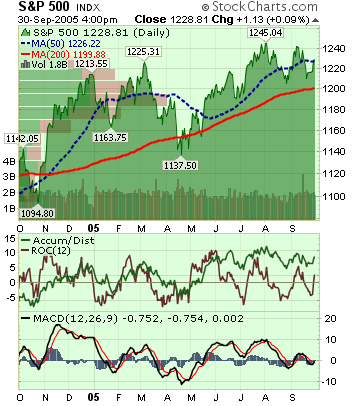Bloomberg:
- US stocks rose for the week, capping their best quarter of the year, as better-than-expected earnings from companies such as PepsiCo and Micron Technology sparked optimism that profits may weather higher energy prices.
- President Bush said he expects more insurgent attacks in Iraq before its citizens vote in two weeks on a new constitution, and he urged Americans to hold firm in the struggle against terrorism.
- The US dollar capped its third straight quarterly gain against the euro and the yen, the longest winning streak since 2001.
- At least 25 people were killed and 95 wounded on the Indonesian resort island of Bali in attacks that were probably conducted by three suicide bombers.
- Exxon Mobil’s $12.8 billion Sakhalin-1 project started producing oil and natural gas in Far East Russia a decade after the government and partners signed a contract to share production from the venture.
- Exxon Mobil of the US and China National Petroleum of China were among winners of permits to search for oil and gas at an auction in Libya, the country with Africa’s largest crude-oil reserves.
- JFE Steel Corp., Japan’s second-largest steel producer, said prices of iron ore and coking coal will probably decline next year on increased supplies.
- A rally in India’s stock market, the second-best performer in Aisa since the Congress Party took power 16 months ago, may be over as earnings growth slows.
- NRG Energy agreed to buy electricity producer Texas Genco Holdings LLC for about $5.8 billion.
- A tour boat carrying 49 people, many of them senior citizens, capsized this afternoon on Lake George, New York, killing 21 people.
- Confidence among executives at Japan’s largest manufacturers rose less than estimated in September.
- China’s oil and gas reserves will grow steadily in the coming 20 years and crude production will reach 150 million tons in 2010, a senior official from PetroChina said.
Barron’s:
- Edwards Lifesciences Corp., the world’s largest maker of artificial heart valves, plans to restart trials of a non-surgical valve after halting a previous study this summer when two patients died.
- MBIA Inc. is being investigated by US and NY prosecutors for not fully disclosing its investment risk in a 1996 purchase of a 46% stake in Capital Asset Research, then the biggest US tax-lien investor.
Fortune:
- Five myths about high oil prices.
Washington Post:
- Ronnie Earl, the Democratic district attorney for Travis County, Texas, said his indictment of Republican US Representative Tom DeLay has nothing to do with politics.
NY Times:
- Teach for America, a group that sends some graduates of top US colleges into the poorest schools for two years, received a record 17,350 applications this year.
- Advertising companies and television networks are working to develop a new product placement strategy that incorporates brands into the story lines of scripted television shows.
- Companies such as Time Warner and Motorola are buying back their own stock at a record pace as executives look for ways to spend surplus cash.
Philadelphia Inquirer:
- Merck & Co. is defending itself from allegations its Vioxx painkiller helped cause heart attacks by highlighting the fact that some of its most senior employees, including its marketing chief and the wife of its chief executive, took the drug regularly.
AP:
- Google is offering to connect all of San Francisco with free wireless-fidelity service, hoping such a move would allow it easier access into the telecommunications industry.
Financial Times:
- Infosys Technologies Ltd. plans to hire 6,000 software programmers in China as demand expands in the country’s $30 billion technology-services industry.
Independent:
- UK entry to the euro is “not on the agenda” and won’t take place for at least 10 years, citing an interview with former Chancellor of the Exchequer Kenneth Clarke.
Basler Zeitung:
- Chiron Corp., a US vaccine maker part-owned by Novartis AG, may in three to four years have developed a faster way to make vaccines for bird flu.
Commercial Times:
- Broadcom Corp. started ordering chips from United Microelectronics this year in a bid to ensure stable supply.
Sunday Business Post:
- Petrel Resources Plc, an Irish oil and gas exploration company, is set to sign an agreement with Iraqi oil officials to help identify new resources in the country.
Weekend Recommendations
Barron's:
- Had positive comments on COP, TEX, MER, CVX, C, STA, AIG and MOT.
- Had negative comments on RHAT.
Goldman Sachs:
- Reiterated Outperform on LUV, ROH, ROC and CEM.
Night Trading
Asian indices are -.50% to unch. on average.
S&P 500 indicated +.06%.
NASDAQ 100 indicated +.09%.
Morning Preview
US AM Market Call
NASDAQ 100 Pre-Market Indicator/Heat Map
Pre-market Commentary
Before the Bell CNBC Video(bottom right)
Global Commentary
Asian Indices
European Indices
Top 20 Business Stories
In Play
Bond Ticker
Daily Stock Events
Macro Calls
Rasmussen Consumer/Investor Daily Indices
CNBC Guest Schedule
Earnings of Note
Company/Estimate
AES/.15
Upcoming Splits
SRZ 2-for-1
Economic Releases
10:00 am EST
- Construction Spending for August is estimated to rise .4% versus an unchanged reading in July.
- ISM Manufacturing for September is estimated to fall to 52.0 versus a reading of 53.6 in August.
- ISM Prices Paid for September is estimated to rise to 74.0 versus a reading of 62.5 in August.
span style="font-style:italic;">Afternoon
- Total Vehicle Sales for September are estimated to fall to 16.1M versus 16.8M in August.
- Domestic Vehicle Sales for September are estimated to fall to 12.8M versus 13.3M in August.
BOTTOM LINE: Asian Indices are lower, spurred by losses in financial shares in the region after a Japanese manufacturing report failed to meet expectations. I expect US stocks to open modestly higher on increased optimism heading into the final quarter of the year. The Portfolio is 100% net long heading into the week.
